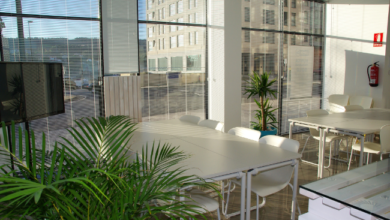Enterprise loom 130m 10m 120kroofbloomberg

Enterprise loom 130m 10m 120kroofbloomberg As technology continues to evolve, so do the needs of businesses. One such need is for a more efficient and effective way to produce textiles. Enter the enterprise loom 130m 10m 120kroofbloomberg, a revolutionary piece of machinery that promises to revolutionize the textile industry. But what exactly is an enterprise loom, and how does it work? In this article, we will explore the design, implementation, advantages, and disadvantages of this cutting-edge technology to help you understand why it has become such a hot topic in the business world.
The Need for an Enterprise Loom
As businesses grow, so do their production needs. The demand for high-quality textiles and fabrics increases, and traditional looms may not be able to keep up with the pace. This is where the need for an enterprise loom comes in.
An enterprise loom is designed to handle large-scale textile production efficiently. It can weave fabrics of varying widths and lengths, making it ideal for industrial use. With its advanced technology, an enterprise loom can produce high-quality fabrics at a faster rate than traditional looms.
The need for an enterprise loom is evident in industries such as fashion, furniture, and automotive manufacturing. These industries require large quantities of fabrics that meet specific standards in terms of durability, texture, and color. An enterprise loom can deliver on these requirements while also reducing production time and costs.
In summary, the need for an enterprise loom arises from the growing demand for high-quality textiles in various industries. Its ability to handle large-scale production efficiently makes it a valuable asset to any business looking to increase productivity while maintaining quality standards.
The Design of the Enterprise Loom
When designing the Enterprise Loom, several factors were taken into consideration to ensure that it would meet the needs of modern businesses. The loom was designed to be highly customizable, allowing companies to tailor it to their specific needs and requirements. This means that businesses can choose the type of fabric they want to weave, as well as the size and shape of the loom itself.
The Enterprise Loom is also designed with efficiency in mind. It uses advanced technology to automate many of the processes involved in weaving, reducing the need for manual labor and increasing productivity. Additionally, the loom is equipped with sensors that monitor its performance in real-time, allowing operators to quickly identify and resolve any issues that may arise. Overall, the design of the Enterprise Loom is focused on providing businesses with a flexible and efficient solution for their weaving needs.
The Implementation of the Enterprise Loom
Now that we have discussed the design of the Enterprise Loom, let’s move on to its implementation. The implementation process involves setting up the loom in a way that is conducive to efficient and effective weaving. This includes installing the loom in a spacious area with ample lighting and ventilation, as well as ensuring that all necessary tools and materials are readily available.
One of the key components of implementing an Enterprise Loom is training personnel on how to use it properly. This involves providing comprehensive training sessions for operators, technicians, and maintenance staff. It is important that everyone involved in operating the loom understands its capabilities and limitations, as well as how to troubleshoot any issues that may arise during operation.
Another important aspect of implementing an Enterprise Loom is ensuring that it is integrated seamlessly into existing production processes. This requires careful planning and coordination with other departments within the organization. By doing so, companies can maximize their return on investment by increasing productivity and reducing waste.
Overall, implementing an Enterprise Loom requires careful planning, attention to detail, and a commitment to ongoing training and support. However, for companies looking to stay competitive in today’s fast-paced business environment, investing in this technology can provide significant benefits in terms of increased efficiency, improved quality control, and reduced costs.
The Advantages of the Enterprise Loom
The Enterprise Loom 130m 10m 120k RoofBloomberg is a game-changer for businesses that require large-scale weaving capabilities. The advantages of this loom are numerous and significant. Firstly, the Enterprise Loom is highly efficient, allowing for faster production times than traditional looms. This means that businesses can meet their production targets quicker, resulting in increased profits.
Secondly, the Enterprise Loom is incredibly versatile. It can handle a wide range of materials and fabrics, making it ideal for businesses that require flexibility in their weaving processes. Additionally, the loom’s advanced technology allows for precise control over the weaving process, ensuring consistent quality across all products.
Another advantage of the Enterprise Loom is its durability. Built to withstand heavy use and harsh conditions, this loom is designed to last for years without requiring significant maintenance or repairs. This means that businesses can rely on the loom to perform consistently over an extended period.
Overall, the Enterprise Loom 130m 10m 120k RoofBloomberg offers many advantages to businesses looking to improve their weaving processes. From increased efficiency and versatility to durability and consistency in quality, this loom is a valuable investment for any enterprise looking to stay ahead of the competition.
The Disadvantages of the Enterprise Loom
While the Enterprise Loom offers numerous benefits, there are also some disadvantages that must be considered. One of the main drawbacks is the cost of implementation. The Enterprise Loom is a complex and sophisticated system that requires significant investment in terms of time, money, and resources. This can be a major barrier for small businesses or startups with limited budgets.
Another potential disadvantage is the need for specialized expertise to operate and maintain the Enterprise Loom. The system involves advanced technology and requires skilled professionals who can handle its complexities. This means that companies may need to invest in training or hire additional staff to manage the loom effectively.
Finally, there is always a risk associated with any new technology implementation. While the Enterprise Loom has been thoroughly tested and proven effective, there is still a chance that unforeseen issues could arise during operation. Companies must be prepared to address any problems quickly and efficiently to minimize downtime and avoid negative impacts on their operations.
Despite these challenges, many companies have found that the benefits of implementing an Enterprise Loom far outweigh the potential drawbacks. By carefully considering these factors and planning accordingly, businesses can successfully integrate this innovative technology into their operations and reap its rewards for years to come.
Conclusion
In conclusion, the Enterprise Loom 130m 10m 120kroofbloomberg is a revolutionary innovation that has the potential to transform the textile industry. Its unique design and implementation have made it possible for businesses to increase their production capacity while reducing costs and improving efficiency. The advantages of this loom are numerous, including its ability to produce high-quality fabrics at a faster rate, its low maintenance requirements, and its user-friendly interface. However, as with any new technology, there are also some disadvantages that need to be considered before investing in this product. Overall, the Enterprise Loom is an exciting development that promises to revolutionize the textile industry and provide businesses with a competitive edge in today’s fast-paced market.




